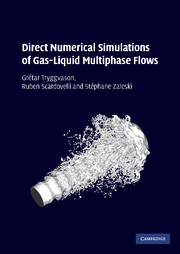Book contents
- Frontmatter
- Contents
- Preface
- 1 Introduction
- 2 Fluid mechanics with interfaces
- 3 Numerical solutions of the Navier–Stokes equations
- 4 Advecting a fluid interface
- 5 The volume-of-fluid method
- 6 Advecting marker points: front tracking
- 7 Surface tension
- 8 Disperse bubbly flows
- 9 Atomization and breakup
- 10 Droplet collision, impact, and splashing
- 11 Extensions
- Appendix A Interfaces: description and definitions
- Appendix B Distributions concentrated on the interface
- Appendix C Cube-chopping algorithm
- Appendix D The dynamics of liquid sheets: linearized theory
- References
- Index
8 - Disperse bubbly flows
Published online by Cambridge University Press: 07 October 2011
- Frontmatter
- Contents
- Preface
- 1 Introduction
- 2 Fluid mechanics with interfaces
- 3 Numerical solutions of the Navier–Stokes equations
- 4 Advecting a fluid interface
- 5 The volume-of-fluid method
- 6 Advecting marker points: front tracking
- 7 Surface tension
- 8 Disperse bubbly flows
- 9 Atomization and breakup
- 10 Droplet collision, impact, and splashing
- 11 Extensions
- Appendix A Interfaces: description and definitions
- Appendix B Distributions concentrated on the interface
- Appendix C Cube-chopping algorithm
- Appendix D The dynamics of liquid sheets: linearized theory
- References
- Index
Summary
Introduction
Understanding and predicting bubbly flows is of critical importance in a large number of industrial applications, including boiling heat transfer in power plants, various metallurgical processes, and in bubble columns in the chemical industry. In bubble columns, used for partial oxidation of ethylene to acetaldehyde, isobutene separation, wet oxidation of heavily polluted effluent, and the production of synthetic fuels, for example, gas is injected at the bottom and, as the bubbles rise, the gas diffuses into the liquid and reacts (Furusaki et al., 2001). Bubble columns ranging from tens to hundreds of cubic meters are common in the chemical industry and up to thousands of cubic meters in bioreactors, where longer process times are needed. The absence of any moving parts and their relatively simple construction makes bubble columns particularly attractive for large-scale operations (Deckwer, 1992). Their operation, however, is usually dependent on the size of the vessel and the difficulty of scaling up small pilot models makes numerical predictions important. Similar considerations apply to other bubble systems.
Computational modeling of industrial-size multiphase flow systems must by necessity rely on models of the average flow. Such models range from simple mixture models to more sophisticated two-fluid models, where separate equations are solved for the dispersed and the continuous phase. Since no attempt is made to resolve the unsteady motion of individual bubbles, closure relations are necessary for the unresolved motion and the forces between the bubbles and the liquid.
Information
- Type
- Chapter
- Information
- Direct Numerical Simulations of Gas–Liquid Multiphase Flows , pp. 187 - 203Publisher: Cambridge University PressPrint publication year: 2011
